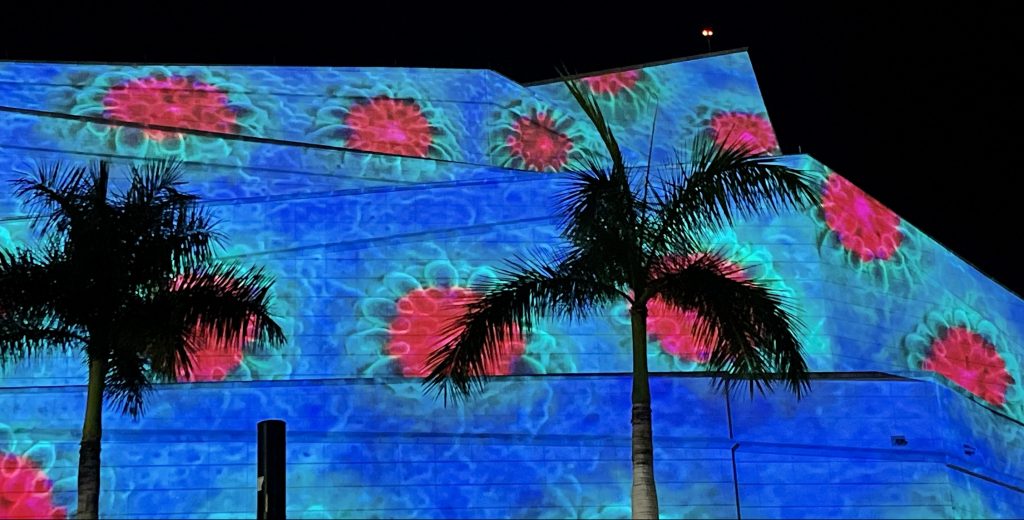
Exploring the future of story in Detroit
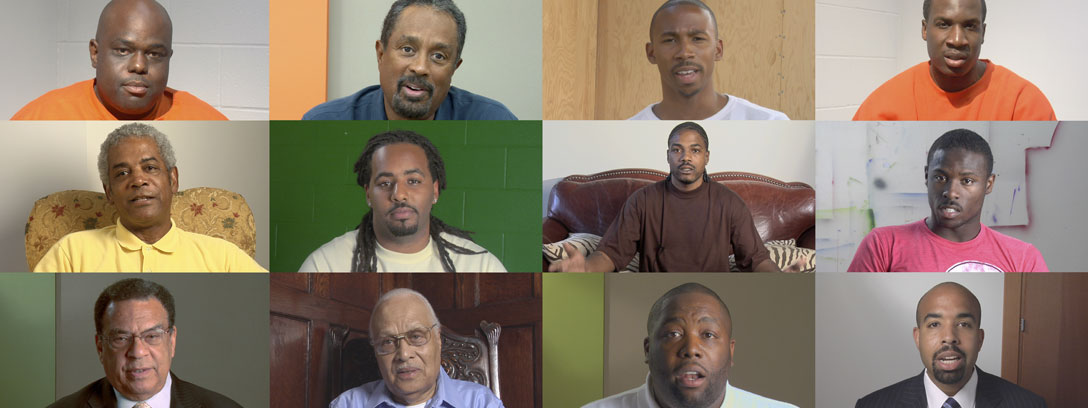
Bayete Ross Smith’s “Question Bridge: Black Males”
This article is cross-posted with permission from Sundance.org.
What is the future of story?” Kamal Sinclair, co-director of Sundance Institute’s New Frontier Story Lab, asks in her welcoming remarks. I came to the New Frontier Day Lab at the Allied Media Conference (AMC) this year because I have this same question. What does my future as a filmmaker look like and how is the art of storytelling expanding and the technical craft changing? Just like the cinematic leaps we’ve taken from black-and-white to color, to sound to film to digital and beyond, is the “communication architecture” in which we tell our stories about to take another leap that I need to prepare myself for? Artists are projecting moving images onto people’s retinas these days, and I’m still trying to figure out my 90-minute, 3-act structured drama/comedy with sharpies, notecards and double-sided tape on a big empty wall. Yes, this has produced fine results and allowed me to tell my stories, but does transmedia mean that this linear structure is outdated? Is transmedia something I have to participate in if I want my work to remain relevant?
Is the transmedia world expanding the method in which we derive our stories, or just the way we are telling them? Is it replacing what we already know about storytelling or giving us more options in which to tell our stories?
The merger itself of Sundance and AMC is a powerful one for Detroit. Both of these organizations have been part of my artistic development as a filmmaker and have worked to facilitate discussions around how the convergence of story and technology impact justice and social movements, furthering the aims of using the power of cinema and media to promote broader cultural understanding and inspire curiosity. It’s great when people have your back and I am thrilled that Sundance and AMC are bringing these labs and ways to continue these important discussions to Detroit!
The lab itself began as we were introduced and greeted with “Welcome to Detroit! Look around you, you are in a place where many great artists are born and bred.” We then met three transmedia artists and Sundance fellows while hearing about their current creative work and how their practice fits into this new form of transmedia. As an Arab American filmmaker, I am very conscious of the context that I produce film in, having become aware at a young age that the images of Arab people I was seeing in mainstream media did not match the community I knew and loved. And coming from an appreciation of film as a medium that explores the subtle nuances of the human experience and condition, but critical of how the majority of those nuances are depicted through the lens of a white male protagonist while all other characters literally become the “other,” I was interested to hear other filmmakers who were also creating with this critical eye on the history of the medium.
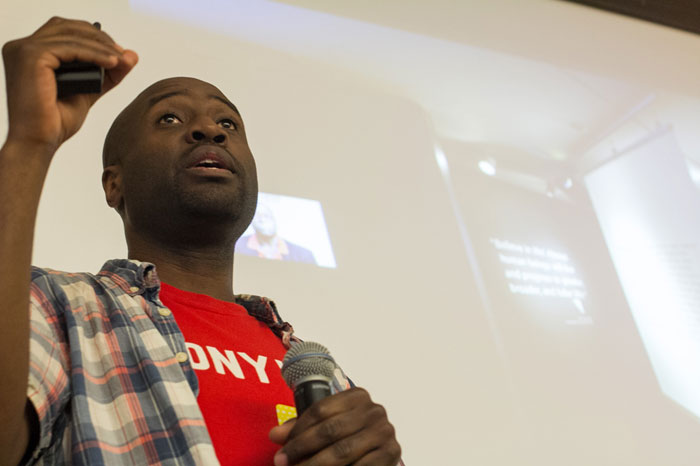
We are introduced to Bayete Ross Smith, the creator of Question Bridge: Black Males, an innovative transmedia project that facilitates a dialogue between a critical mass of black men from diverse and contending backgrounds and creates a platform for them to represent and redefine black male identity in America. Bayete starts by projecting headshots of Black men and women in various clothing and asked us to identify each character. “A yoga instructor,” “a guy walking home from school,” “looks like my cousin,” people answered.
“Who controls the images and stories that are used to define us? Who gets to brand a certain truth?” Smith asks. Commenting on process and the importance of figuring out who your target audience is, Smith referred to his work as an examination of identity and a window into one demographic category.
Creative technologist and new media artist, Yasmin Elayat (18 days in Egypt) was working with the idea that anyone can participate. Her project started out as a documentary film, which then expanded into a web-based platform where people started uploading photos and videos to build a crowd-sourced depiction of the Egyptian revolution. It was information gathering and sharing on a massive grass roots scale, literally from the ground up from all sides of the revolution. Elayat and her team would shift the story with each new element. She stressed the importance of failing in order to learn: “We didn’t know what it was going to be and that was okay”.
But it can be difficult to keep up. “We are at the mercy of current events, and people get tired and move on from movements and sharing media,” Elayat explains. But she stressed that one of the most important things is that this work counters our “collective amnesia” by archiving the stories that the mainstream media refuses to cover.Defining Transmedia
Sarah Wolozin, director of the MIT Open Documentary Lab, was defining participatory documentary, which in the history of media production, some suggest is an entirely new art form. Sarah talks about creating empathy through participatory components. She discussed a project that had audience members talk to robots and that these robots were able to elicit genuine, honest emotions from the humans they were engaging in conversation. Maybe people found themselves able to open up to a robot because there simply is no history of pain and confusion with this “person.”Interaction Design: Story, Platform, Audience
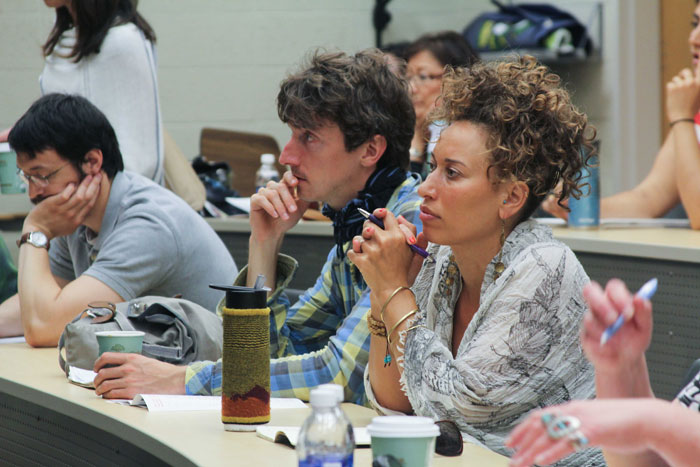
Attendees at the New Frontier Story Lab in Detroit. Photo © Sundance Institute. Credit: Bree Gant
Though in the “robots have never hurt us” scenario that my brain was cooking up in all of this, it was clear from Kamal Sinclair’s opening remarks and throughout the presentations, that transmedia storytelling had not taken a backseat to technology. Questions like “Does your story call for audience interactivity?”; “Why is the story being told this way?”; “What value is interactive media bringing to the story?”; and “How is the structure playing a role in the telling of the story?” reiterated for me the fact that these transmedia artists were more interested in ideas of story than they were in ideas of technology. During the discussion about Elayat’s project, she commented that “history has already been written by the community,” illustrating the idea that in transmedia works, the story’s content may already be there, but the artists job is to find a way to give that content a platform. And if that’s the case, then the design of the platform and the experience of both the users and viewers is important. But where does that leave us, the filmmakers? It was interesting to hear Elayat refer to herself as a “tool maker” – this was something that resonated with me, as I remembered my Dad working at Oldsmobile as a tool grinder when I was young. His job, his craft, was to make things excellent. To sharpen the tools that create the products. I began to think about the fact that no matter what field you are working in, sometimes that sharpening of the tool is all you need to take your experience, your understanding and your perspective, to the next level.
Is this what it meant to be thinking in a transmedia way?
I wasn’t sure, but it was great to be hearing from other artists who were also trying to figure it out in a variety of different ways. Interactive artist Jeremy Mendes presented examples from his work, which dealt primarily with linear narratives that were being presented in an environment that is non-linear – so that the platform or form of the work is the thing that is under restructuring once the artist has a story locked down. Mendes’ main point was that “quite often (people) get excited about form, but we try to keep form and story separated…the challenge is to tie in your concept with the form you are working with. What does that form mean?” He spoke about the importance of creating multiple iterations, then prototypes, and in the face of “design data visualization interface…maintaining your artistic vision is very challenging.”
And here is where I go back to my pen and paper. But I was starting to realize that, for these artists, the processes they were articulating were also about going back to the proverbial drawing board – even if that drawing board was digital, or in a programming language, and not necessarily handwritten on notecards. The common bond that we shared was that we were all working it out. That nothing was certain in our creative processes, and for me this uncertainty made efforts in transmedia more inviting and accessible. It started to feel like we are all trying to figure this out together and the medium is at such an early stage that the only approach we can take is the one all artists take – one where you try, fail and try again.
This process of evolution was familiar to me – working through this murky landscape where you just keep pushing until things click into place is what making a film already feels like. And the element that confirms for me when things do click into place is my audience. Multiple artists throughout the day also commented that audience was an important, if sometimes fluid, facet of transmedia work.
Elayat commented that “we were seeing our audience as composed of three groups. Essentially, the first group is made up of the people who are there—the storytellers. The second group is the people who might have more context to what is going on—they are the research audience. And the third group is those people who will see the project in the future—the future audience. This group is why we sometimes ask ourselves ‘is this project ever done?’”
I began to see that this new medium could be more about decentralizing the storyteller in order to liberate the elements of media production that remain autonomous instead of force through a singular lens. Once those elements are liberated they bypass a filtration, dare I say editing process, and can be realized within their natural context.
Jeremy Mendes also commented on audience, but on his awareness of how the audience views media, the viewing context and processes that they bring to the table, and how this affects the work being viewed. His observation that “the average human attention span is now eight seconds” spurred him to focus on “invention, innovation and diffusion” as methods to retain and keep viewers, asking the group for their thoughts. “Should we push back against this trend or go with it?” My immediate thought is that we should push back. A reduction in our attention span (down to eight seconds!) feels like a linear amputation. And we should get that time back.Generated Narrative
I was slowly moving from an “I work on paper and I am transmedia intimidated ” mode to seeing the opportunities that transmedia could provide to my practice and to the practices of other filmmakers. Transmedia can be a way to present a multilayered, multidimensional approach to storytelling that provides multiple portals of entry for viewers to both engage with the characters’ experiences as well as generate their own narrative content and keep the discussion going beyond the final frame. Characters in the projects presented by the Sundance artists do not only live in a 90-minute linear timeline projected onto a big screen. They live on Twitter, in art installations and in these physical experiences they ask you to join them in. By providing these multiple portals, transmedia also begins to answer a big question for many artists of how our communities and their authors can translate these experiences of marginalization in ways that others can understand.
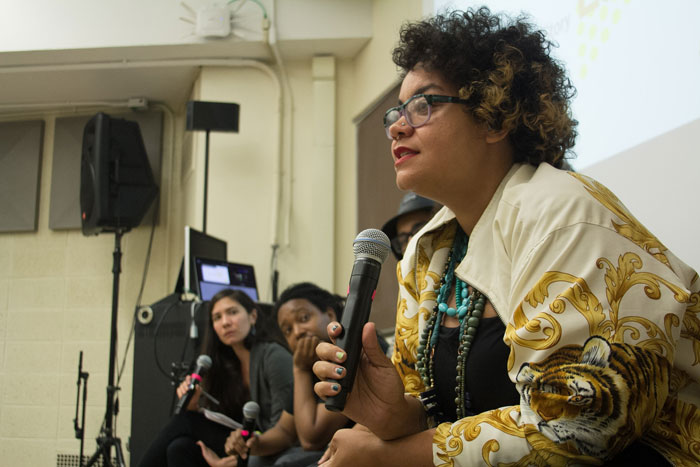
Adrienne Maree Brown speaks on a panel at the New Frontier Day Lab. Photo © Sundance Institute. Credit: Bree Gant
In the afternoon, our time was spent talking through what the creation of transmedia works can provide besides the production of creative work. Detroit-based artists Wes Taylor and Carlos Garcia (Complex Movements), Adrienne Maree Brown, Dream Hampton, Evan Bissell, and moderator Jenny Lee (executive director at Allied Media Projects) asked how can storytelling be self transforming and structure transforming simultaneously?
“What we need now in our dying cities is self-transforming and instructor transforming cities.”
“We are really good at critiquing but it is hard to imagine something else. What would it look like to decentralize power?”
“We are in this imagination battle that is getting more and more vicious. Because white imagination says that we are scary”.
The possibilities that transmedia provides for rewriting the narratives above, for shifting the power structure that these narratives have helped remain in place and for ways that storytelling can be a totally transformative act, were exciting. The idea that transmedia works could possibly extend dialogues beyond the screen was being felt by multiple artists and attendees at this lab. This need for empowerment of others, for tools necessary to be able to take this transformative element into one’s own hands and instigate the changes we each see are needed, was also an exciting possibility.
As Yasmin Elayat was talking about the idea of transmedia as a tool, she also stated, “We need to step back and start to see ourselves as tool makers instead of filmmakers. Allowing people to build a platform that allows them to tell their stories.” This for me made very clear that by allowing others to contribute to the narrative, by providing portals for viewers to have a more engaging experience with those narratives, we as filmmakers could increase the empathy and resonance that our works create by helping to author these participatory documentaries. As Elayat asks, “What if we can change the narrative from one voice to multiple voices?” This made me think of media critic Jack Shaheen who, in his book Reel Bad Arabs, found that nearly 1,000 films depict Arab characters as terrorists, kidnappers or other negative stereotypes. Shaheen states that in order to combat this effect on how society perceives Arab people there must be 1,000 films made with positive depictions in order to balance the scales. But if transmedia can provide multiple portals of entry into these narratives of underrepresented communities of authors, it could be a way to cut down on this catch up time. Instead of watching 10 movies about an Arab gas station clerk in order to understand how sitting behind the plexiglass has shaped his perspective, if I ask you to step into a bulletproof glass fortress that obstructs your vision, muffles your sound and only provides fresh air through one little circle, your experience of this situation is much more immediate and impactful.
But will it be understood? How do we continue to go forward with these ideas as transmedia authors and generators? As Elayat stated in response to whether or not a project is ever done, “I don’t want to believe that the story will end.” I think that was the biggest point for me – while transmedia is not yet a completely defined medium, it is the lack of definition that makes it an exciting form holding possibilities for access by multiple voices, audience and authors. And because the story does not yet have an ending there is still a dialogue that exists.
Recent Content
-
Artsarticle ·
-
Artsarticle ·
-
Artsarticle ·
